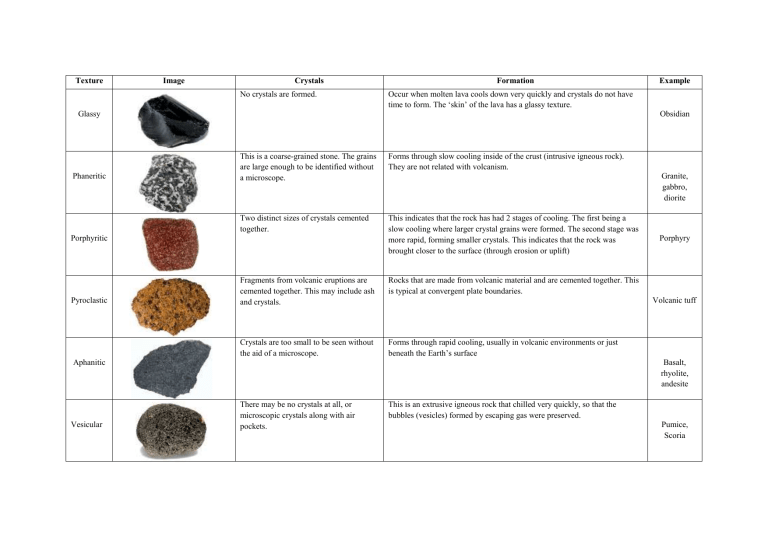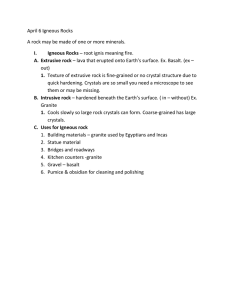
Texture Image Crystals No crystals are formed. Formation Occur when molten lava cools down very quickly and crystals do not have time to form. The ‘skin’ of the lava has a glassy texture. Glassy Phaneritic Obsidian This is a coarse-grained stone. The grains are large enough to be identified without a microscope. Forms through slow cooling inside of the crust (intrusive igneous rock). They are not related with volcanism. Two distinct sizes of crystals cemented together. This indicates that the rock has had 2 stages of cooling. The first being a slow cooling where larger crystal grains were formed. The second stage was more rapid, forming smaller crystals. This indicates that the rock was brought closer to the surface (through erosion or uplift) Porphyritic Pyroclastic Granite, gabbro, diorite Fragments from volcanic eruptions are cemented together. This may include ash and crystals. Rocks that are made from volcanic material and are cemented together. This is typical at convergent plate boundaries. Crystals are too small to be seen without the aid of a microscope. Forms through rapid cooling, usually in volcanic environments or just beneath the Earth’s surface Porphyry Volcanic tuff Aphanitic Vesicular Example Basalt, rhyolite, andesite There may be no crystals at all, or microscopic crystals along with air pockets. This is an extrusive igneous rock that chilled very quickly, so that the bubbles (vesicles) formed by escaping gas were preserved. Pumice, Scoria Vesicular This is a coarse-grained stone. The grains are large enough to be identified without a microscope. This indicates that the rock has had 2 stages of cooling. The first being a slow cooling where larger crystal grains were formed. The second stage was more rapid, forming smaller crystals. This indicates that the rock was brought closer to the surface (through erosion or uplift) Crystals are too small to be seen without the aid of a microscope. This is an extrusive igneous rock that chilled very quickly, so that the bubbles (vesicles) formed by escaping gas were preserved. Volcanic tuff Pyroclastic Obsidian Aphanitic Basalt, rhyolite, andesite Vesicular This is a coarse-grained stone. The grains are large enough to be identified without a microscope. This indicates that the rock has had 2 stages of cooling. The first being a slow cooling where larger crystal grains were formed. The second stage was more rapid, forming smaller crystals. This indicates that the rock was brought closer to the surface (through erosion or uplift) Crystals are too small to be seen without the aid of a microscope. This is an extrusive igneous rock that chilled very quickly, so that the bubbles (vesicles) formed by escaping gas were preserved. Volcanic tuff Pyroclastic Obsidian Aphanitic Basalt, rhyolite, andesite


